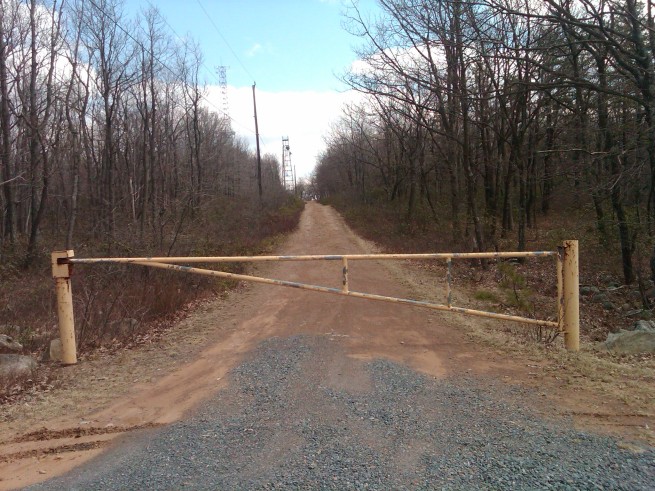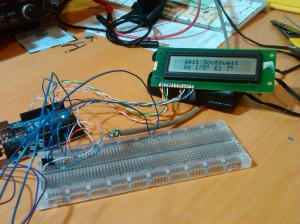Posts Tagged ‘Uncategorized’
 Success
Success
On Good Friday I was able to get out and make another attempt at a Summits on the Air (SOTA) activation. This time I was successful, making a short run of contacts on 15 meters into Europe and activating summit W3 / PO-23. It was windy and cold with some occasional snow flurries, but I was able to setup the station in a rock outcropping to shield myself from the wind.
My rocky QTH

My portable station: an FT-817, BLT tuner, and modified Whiterook paddle
At this rate it will take some 250 summits to get to the famed Mountain Goat status, not considering bonus points for winter activations. There are only 220 summits in the W3 SOTA association, so quite a bit of travel and planning would be necessary to pull this off. But I’m in no rush :-)
 SOTA Activation Attempt #2
SOTA Activation Attempt #2
Trail up to the site
One of the two towers near the site. This is an old firetower now used by Carbon County, PA. The cabin at the top was removed.
The other tower at the site owned by State of Pennsylvania. Well built, though a bit bland by radio artisan standards.
A neat spot on a rocky peak about a mile away from the SOTA summit
 Fresh from the Radio Artisan Lab: Yaesu Rotator Computer Interface / Controller
Fresh from the Radio Artisan Lab: Yaesu Rotator Computer Interface / Controller
I have completed the Arduino-based rotator computer interface and controller project or at least gotten the code and functionality stable and to the point where I’m satisfied with it. The unit emulates the Yaesu controller command set and works with Ham Radio Deluxe. I’ve tested the unit with a Yaesu G-1000DXA rotator. While the code has AZ/EL rotator support, I do not have an AZ/EL rotator to fully test the elevation functionality yet. This summer I hope to assemble a satellite antenna setup complete with an AZ/EL rotator using this interface.
If anyone is able to test with an AZ/EL rotator, or if anyone wants to attempt to interface this to another brand rotator, please let me know as I would be glad to develop the code.
 Appalachian Trail Dreaming
Appalachian Trail Dreaming
Now that the snow has melted and ice fishing season is over, I’m looking forward to doing some Summits On The Air (SOTA) operation on the Appalachian Trail (AT). This video I found from Kevin Gallagher beautifully summarizes a six month AT journey into a few minutes and got me thinking about SOTA operation from the trail.
 QSY
QSY
It’s been a fun ride in the amateur radio blogosphere these past few years. I’ve had some good discussions with intelligent people and had fun along the way. I shared ideas, some good and some half-baked. I had some folks believing that the LORAN network was being saved by radio amateurs, organs were going to be harvested from radio amateurs for universal healthcare, and the Red Hot Chili Peppers liked to jam on amateur radio. I analyzed, complained, praised, and ranted, and a lot of you listened. Several of you presented alternate points of view that provoked thought and sometimes changed my opinions.
Unfortunately, I find it increasingly difficult to write about topics that are consistent with the original intent of this blog. As I’ve often mentioned, I wanted to do something different from the normal “I did this today” blog. A lot of folks like to do that, and that’s OK. A blog is what you want it to be, it’s your creation. There’s only so much I can write about regarding what’s broken or can be improved in amateur radio, and writing about it doesn’t really do anything to fix it. Often in this online world we amass an audience that agrees with our viewpoints and opinions, and critical topics on blogs tend to preach to the converted. Those who really need to read such topics aren’t reading blogs.
Rather than have this blog go on a life support system with periodic and annoying “I’ve been really busy” posts as many amateur radio blogs have done, I’m retiring The K3NG Report and have launched another site entitled Radio Artisan which will focus on projects and operating events, mainly outdoors. While technically it’s hosted with WordPress and essentially is a blog format, I’m not treating it as blog so I don’t feel an obligation to post regularly or write about the amateur radio crisis du jour.
See you over at Radio Artisan…
Thanks for reading and 73. Dit dit.
 Welcome
Welcome
Welcome to Radio Artisan, and a special shout out to former K3NG Report readers. This is my new creation which will focus on projects and operating activities. Links to projects and “sticky” articles are over on the right. I will generally post articles when some new project page has been created or if there’s an update to an existing one.
A few of the pages are past postings from the K3NG Report. The PIC Keyer is a project that I’ve had published for several years now. My newest creations are the Arduino CW Keyer and the Arduino Computer Rotator Interface / Yaesu Rotator Interface Emulator. Both are being actively developed with new features, but are fully functional.
I’m currently on an Arduino kick as you may be able to tell. I also have in the works a frequency counter which will interface with the CW keyer, and a DDS chip controller which may become the basis for a larger project. I also have in the works an Arduino controlled balanced antenna tuner.
If you have any interests in these projects, please be sure to drop me a line.
73
 Promotional Film From The Sixties – Fairchild Briefing on Integrated Circuits
Promotional Film From The Sixties – Fairchild Briefing on Integrated Circuits
As promotional videos go, this is rather interesting. Very detailed and an interesting look at the burgeoning technology of the sixties. Below is a quote from the video description on YouTube:
[Recorded: October, 1967]
This half hour color promotional/educational film on the integrated circuit was produced and sponsored by Fairchild Semiconductor Corporation and first shown on television on October 11, 1967. In the film, Dr. Harry Sello and Dr. Jim Angell describe the integrated circuit (IC), discuss its design and development process, and offer examples of late 1960s uses of IC technology.
Fairchild Semiconductor Corporation was one of the most influential early high-tech companies. Founded in Palo Alto California in 1957 by eight scientists and engineers from Shockley Semiconductor Laboratory, Fairchild Semiconductor Corporation was funded by Fairchild Camera and Instrument Corporation of Syossett, New York. Rapidly establishing itself as a technology innovator based on its invention of the planar manufacturing process in 1959, the company developed the first monolithic integrated circuit, the first CMOS device, and numerous other technical and business innovations. French oil field services company Schlumberger Limited purchased Fairchild in 1979 and sold a much weakened business to National Semiconductor in 1987. In 1997 National divested a group, formed as the present Fairchild Semiconductor, in a leveraged buy-out. The company re-emerged as a public entity based in South Portland, Maine in 1999 under the corporate name Fairchild Semiconductor International, Inc.Fairchild Semiconductor presented its new products and technologies with an entrepreneurial style, and its early manufacturing and marketing techniques helped give Californias Santa Clara County a new name: Silicon Valley. It was one of the early forerunners of what would become a worldwide high-tech industry, as evidenced in this short promotional film.
Pretty neat stuff, brought to you by The Computer History Museum.


















